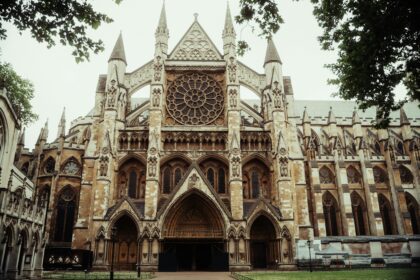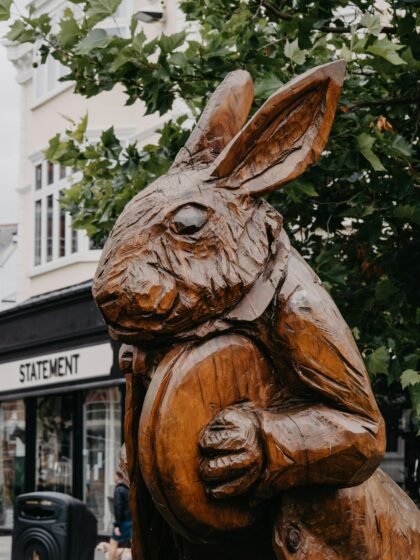
I recently had the great privilege to spend 9 days in London with my family on a sort of mini-sabbatical after 15 years of service at my day job. A subtle but recurring theme to the visit was how often religion and science came up together. For starters, we patronized several bookstores, and every time the science section and the religion section were in the same room. Now, in a suburban Barnes & Noble in the US, that would be unremarkable because the whole store is basically one room. But these were older buildings, more warren than warehouse, where those two sections might fill an entire room. Granted, I can’t be certain these were fully independent observations; all the stores may be operated by the same parent company behind the scenes and thus share organizational guidelines, just as so many of the seemingly bespoke pubs had been bought up and homogenized with a common menu. Still, the topic pairing stood out to me.
More overt and unambiguously intentional was the intermingling of science and religion at Westminster Abbey. I knew Isaac Newton, Charles Darwin and Stephen Hawking were buried there, but it wasn’t until I was preparing for the trip that I realized how many other eminent British scientists were recognized there. Even if many of the others are memorialized while their remains rest elsewhere, the plaques still serve to demonstrate the high regard the Anglican church has for these folks who studied God’s other book alongside the Bible.
At least in most cases. Hawking’s presence is somewhat surprising, given that he was pretty unambiguous in his atheism. And apparently the memorial for Paul Dirac took several years to be approved because he was at times critical of religion–although other writings seem to make allowances for the possibility of theism, suggesting perhaps his issues were more with religious institutions than beliefs. Meanwhile, notably absent as far as I could tell (some monuments and memorials were obscured) was Mary Anning. She had a large wall all about her and her fossil hunting at the Natural History Museum and at least one fossil displayed at the British Museum, but apparently no mention at Westminster Abbey despite her devout Christian faith. I imagine the issue is that while she was a believer, she and her family were dissenters from the Church of England.
I could have missed a marker for Mary Anning, but there was no escaping the reality that Westminster Abbey, however welcoming of visitors from all over the world, is inextricably entwined with the government of England and its state church. Newton and Darwin may have impressive monuments, but they are still overshadowed by the tombs of nearly a millenium’s worth of monarchs–from Anglo-Saxon Edward the Confessor who died in 1066 to George II who died in 1760. I don’t want to overstate the connection; I recognize that the modern United Kingdom is substantially more pluralistic and secular than when Edward the Confessor commissioned the first abbey. Still, for an American visitor it is a striking reminder that separation of church and state is not a default position and there were reasons the founders of the US had to make specific allowances for it.

The presence of Darwin served as a reminder that separation of religion and science is also something that was explicitly pursued. Government research grants have not always existed; there were times when science was a pursuit which required independent income. One option was to inherit wealth and/or earn passive income; the British Museum stands in no small part as a testament to what a combination of curiosity and disposable income can achieve. Another option was to be employed by the church, which provided some flexibility in how one chose to pursue one’s calling. Thomas Huxley’s efforts to make the practice of science a profession in its own right and thus accessible to folks other than clergy and the wealthy mingled with his advocacy for Darwinian evolution; perhaps in a different economic and political setting, support for evolution might not have been so closely linked to separating science from the church.
We also visited the Roman baths in Bath, another site where religion and political power mingled and influenced understanding of the physical world. We learned how the baths served a variety of purposes beyond (but not excluding) cleanliness. The physical building the Romans erected and the decor they chose demonstrated the power that Rome and the emperor had to co-opt and subvert local religious practices. Still, on top of the layers of subtext, they had effective exercise programs, a sense that being clean promoted good health, and knowledge of plants that could facilitate healing for various ailments. Obviously we’ve accumulated knowledge since then, but they were neither incurious nor ignorant. Their beliefs that the gods played a directly causal role in much of daily life did not mean those were the only causal forces they recognized.
Eventually our London adventure came to an end. It is tempting to imagine someone from Roman Briton or an Anglo-Saxon or even Isaac Newton or Charles Darwin joining me on flight home. What would they have thought about eating a hot meal while traveling over 500 miles per hour at 30,000 feet above sea level, all the while streaming a movie like Jurassic World: Dominion from a server on the ground? Which bits would seem most miraculous? Even for myself, it’s still pretty remarkable. And I am still grateful to God that it all worked so well, even if I also understand how the Bernoulli principle and video codecs and microwave ovens also factor in. In that respect, my hypothetical travel companions and I might have more in common than not.
Andy has worn many hats in his life. He knows this is a dreadfully clichéd notion, but since it is also literally true he uses it anyway. Among his current metaphorical hats: husband of one wife, father of two teenagers, reader of science fiction and science fact, enthusiast of contemporary symphonic music, and chief science officer. Previous metaphorical hats include: comp bio postdoc, molecular biology grad student, InterVarsity chapter president (that one came with a literal hat), music store clerk, house painter, and mosquito trapper. Among his more unique literal hats: British bobby, captain’s hats (of varying levels of authenticity) of several specific vessels, a deerstalker from 221B Baker St, and a railroad engineer’s cap. His monthly Science in Review is drawn from his weekly Science Corner posts — Wednesdays, 8am (Eastern) on the Emerging Scholars Network Blog. His book Faith across the Multiverse is available from Hendrickson.

Leave a Reply